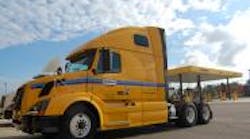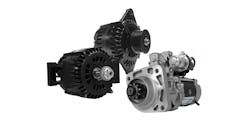“These are some pretty impressive numbers.” –Ralph Stockmayer, manager of sustainability, Penske Truck Leasing
I had the chance to sit in on a Discovery Forum 2010 session put together by Penske Truck Leasing the other day at one of its new facilities in Chester, VA – located just a little ways south of Richmond, the state’s capital.
Penske is holding a total of nearly 20 Discovery Forum sessions at select locations chosen from its nearly 1,000 facilities in the U.S. to help update its customer base on two critical topics: the new emission control technology installed on today’s trucks and the ramifications of the Federal Motor Carrier Safety Administration’s (FMCSA) new Comprehensive Safety Analysis 2010 (CSA 2010) regulations, due to start going into full effect by November.
The reason Penske is doing this is pretty simple, Chris Anderholm, the company’s area vice president for the Carolinas, told me: there’s an awful lot of change happening very fast right now in trucking, so fleets need to get up to speed quickly on how these changes will affect their operations.
“Since 2002, we’ve witnessed an extraordinary amount of change in this industry, especially in terms of emission technology and safety regulations,” he said. “So we wanted to make sure our customers are aware of all that’s happening and how it might change their business.”
Penske tapped longtime veteran Ralph Stockmayer – currently the company’s manager of sustainability – to give an overview of the emission technology issue, relating what information Penske’s been able to glean on the subject over the last few years.
[Here’s a view of some of his presentation. The 2% he talks about in here relates to the consumption of diesel exhaust fluid (DEF), which is discussed further down in this post.]
Now, Stockmayer brings an interesting perspective to this issue. A 42-year veteran of the trucking industry, he spent 29 years as a private fleet manager of a 100-truck operation, with the last 14 spent in various positions within Penske Truck Leasing. He also put together a 32-page primer breaking down the intricacies of truck fuel economy six years ago – a booklet now in its third printing.
Stockmayer began his presentation pointing out a few key facts. First, there are two 2010 emission control technology packages – selective catalytic reduction (SCR) systems and enhanced exhaust gas recirculation (E-EGR). Second, only Navistar, which builds International-braded trucks and MaxxForce-branded diesel engines, uses E-EGR; everyone else uses SCR.
“We’ve had two years worth of experience with trucks equipped with SCR; both in terms of demonstration units and equipment placed with customers for every day service,” he said. “Unfortunately, we don’t have a similar experience with E-EGR; we haven’t received any of these engines yet.”
That means while Penske has data to report on the performance of SCR, it doesn’t have a comparable set on the E-EGR solution. “This isn’t to say we’re down on Navistar’s solution; in fact, we’ve got 300 trucks on order with them now,” Stockmayer stressed. “We just haven’t had the chance to test it out yet, so we don’t have any performance data.”
With SCR, however, it’s a different story. Stockmayer pointed to a fleet-wide comparison conducted with one of Penske’s customers between trucks equipped with 2007 emission-compliant Detroit Diesel Corp. (DDC) Series 60 engines and DDC’s new 2010 DD-13 models using SCR. Both engines were rated at 455 horsepower, pulling 80,000-pound rigs in the Midwest.
The Series 60 trucks averaged 5.656 miles per gallon (mpg) while the DD-13 trucks delivered an average of 6.3 mpg – an 11.3% gain, Stockmayer reported. Now, that figure needs to be reduced by 2% to account for the amount of diesel exhaust fluid (DEF) being sprayed into the exhaust stream as part of the SCR solution to reduce oxides of nitrogen (NOx) emissions down to the required level of 0.2 grams per brake horsepower hour (g/hp-hr).
Still, said Stockmayer, a net 9.3% fuel economy gain is impressive – especially since the OEMs predicted a far more conservative 3% to 5% gain.
Penske is now also ordering Volvo VNL sleeper-cab tractors, equipped with Volvo’s own D13 engine. Stockmayer noted that a demonstration Volvo VNL unit being shared with Penske customers achieved 6.91 mpg on a 500-plus mile run, despite nearly 45% engine idle time – again, a significant fuel economy achievement.
Now, this doesn’t mean the SCR experience is all peaches and cream. For starters, it is adding anywhere from $8,500 to $11,000 to the list price of a 2010 truck, depending on its gross vehicle weight (GVW) and engine displacement. There’s also the additional weight of the SCR components to factor in, additional maintenance required for the system, as well as the consumption of DEF to consider as well.
“Right now, we’re seeing an average of 2% DEF consumption – roughly two gallons of DEF for every 100 gallons of diesel fuel,” Stockmayer said. Roughly, that means drivers will need to fill up with DEF about every third time they fill up on fuel.
So far, the per-gallon cost of DEF is running equal to diesel fuel except when sold in small volumes, he noted, such as the two gallon bottles available in truckstops; those “jugs” are running $4 to $5 right now per container.
Still, even with all of that taken into consideration, Penske’s data shows that SCR is proving itself rather well in the field – especially in terms of boosting fuel economy. And if those fuel savings stay consistent, it could help fleets generate a decent return on investment (ROI) to help them offset the higher initial cost and ongoing maintenance expense of this new technology.
Only time will tell.



